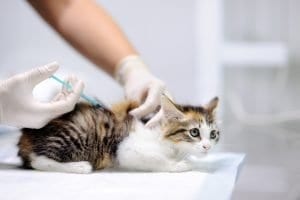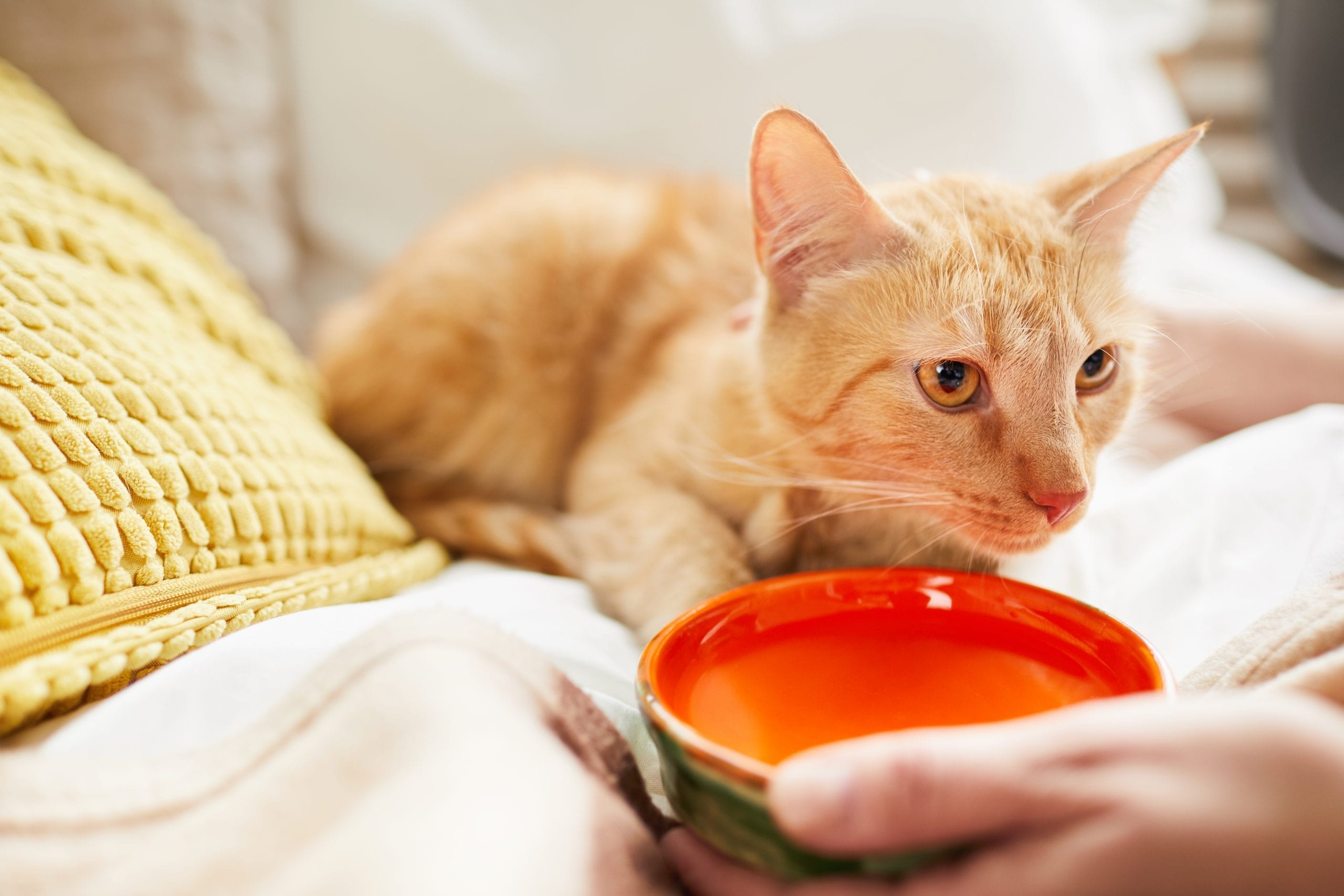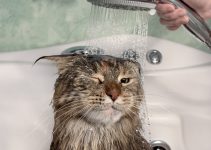Water is very important for living creature on earth, and cats are no exception. Every cat owner knows that they should provide their cats with fresh and clean water constantly. However, you might notice sometimes that your cat’s water consumption has increased. Sometime, you wonder why is your Cat drinking a lot of water and Vomiting.
So how would you tell, and what would make you say that your cat is drinking so much water ? And what is normal or abnormal to your cat?
NOTE: We want to inform our blog readers that before we publish any article, the team “Proudcatowners” does deep research based on experience and knowledge about cats and everything related to them, to guarantees reliable and precise information, satisfy the readers is our first priority.
Cat drinking a lot of water and Vomiting
250 ml of water is the approximate amount of an average 4 to 5 kilograms cat should be drinking in 24 hours, to keep itself well moisturized.
But if you primarily feeding your cat moisturized food, then he or she is getting 80% of the moisture from that food, then drinking just 30 ml of water would be enough for your cat.
Seeing your cat just bent over a water bowl drinking and drinking, then seeing it urinating a lot, it means that something is happening and should take things seriously and go see a Vet. We will first get to know why your cat urinates and drinks a lot of water, and then what causes your cat to vomit or throw up a lot.
Now we will get to know why your cat drinks more water
- If it is too hot then your cat may drink more water to cool his body, and it is a natural cooling
- Salty and dry food could cause an increase in thirst that leads to an increase in excess of water
- If your cat is playing a lot and running then he may get thirsty and a little bit of an increase in water drinking is normal
But seeing your cat urinating or vomiting a lot that means there is a problem and you have to put in mind that the sooner you can catch the problem the sooner you can start treatments
Polydipsia means that your cat drinks more than usual
Polyuria means that your cat urinates more than usual
Blood test

Getting to know if there is any diabetes, kidney or liver disease. and a lot more diseases like infections and anemia in cats.
Getting a urinalysis
Getting a clear clean little box and collect some urine of your cat for analysis examinations to the laboratory to get to know if your cat has diabetes.
Chronic Kidney Disease
Up to 35% of cats when they pass the age of 13 at some degree they have a kidney-failure, the role of a kidney is to filter your cat’s blood, so when it’s not working as effectively as it should be then the kidney is no longer able to concentrate the urine and filter the blood properly. So instead the urine coming out very concentrated it comes out very clear, that means the toxins like Uria Creatinine still there in the cat’s blood system and make them sick.
- Avoid feeding your cat phosphorous also called aluminium hydroxide or Al OH, it is the primary nutrient that’s damaging the kidney.
Diabetes Mellitus
In that condition, your cat’s pancreas is not producing enough insulin, then a cat is no longer able to take that blood sugar to get it back into their cells to use it appropriately. Cats are obligate carnivores and designed not to just survive but they thrive that’s why they need animals protein, that means they are not designed to digest carbohydrates, feeding your cat more sugary or carbohydrates means more insulin produced means likely pancreas getting tired. Avoid feeding your cat kibbles or food that contains sugar, and try to feed him high protein cat food.
Liver Disease
In some cases, you can see secondary clinical changes you might see that your cat is jaundice, in terms of yellowing around the whites of the eyes, the base of the ears around the skin, gum of the mouth is also yellow instead of the nice pink color. If you see this, then your cat may have liver disease and you have to see a veterinary to determine the underlying cause of that liver disease, if is it a fatty liver, hepatic lipid OSIS or cholangitis Quando hepatitis.
In this case, cats need adequate nutrition and need to be eating more than any other remedy. Feed your cat high quality protein canned food
Hyperthyroid
Your cat’s thyroid gland enlarges at the base of their neck, in that case, the cat is eating more and got a voracious appetite but losing weight and often drinking a lot of water than normal. The main gland is producing a hormone that regulates your cat’s metabolism, that’s why you may see an increase of the appetite
To get to know if your cat is drinking too much water than normal, you can check this at your home using a measurements cap or bowl to measure the amount of water you put in it at the beginning of the day, and then you will get to know the amount of water your cat drank at the end of the day, divide the value obtained by the weight of your cat. If the result is higher than 45 ml per kg, then you should contact a veterinarian. Just make sure that your cat is drinking just from that cup or bowl.
Why does my cat vomit?
Are you asking why your cat vomit? So Keep in mind that there is a lot of reasons why cats throw up, and there is not one specific cause for vomiting.
A cat regularly vomits the hair it swallowed by licking, or a food swallowed too quickly or in a context of stress, But don’t make the mistake of thinking that these regurgitation are normal, they can hide a more serious illness or disorder. In this case, it is best to act to preserve the well-being of your animal.
Vomiting in cats is one of the defense mechanism has his body to deal with poisoning in reaction to the development of a pathology which directly affects the digestive system, knowing the most common causes which explains this regurgitation can help us avoid and act quickly if its product, and why cats vomit and in which case it is necessary to go to see a VET.
An inappropriate diet will cause problems in animals digestive tracts that can manifest as a form of vomiting or diarrhea, cats being strictly carnivorous it is necessary to provide them with a diet based on protein consumption of quality such as meat, tuna, chicken. On the other hand, it should be noted that a sudden change in a diet can also cause vomiting and diarrhea because cats are very sensitive animals, and this type of change has to be done gradually.
The intolerance and allergic foods: if you are feeding your cat the same food for a long period time, it will provoke vomiting and diarrhea even skin problems such as irritation, redness, inflammation and itching in certain areas like the face, ears and lower body, so it’s important to vary the diet of your cat time to time
gastroenteritis: it is an inflammation of the digestive tract which may have certain various causes ranging from bad digestion to an infection, from vomiting to diarrhea, discomfort, lethargy and even fever. If your cat has gastroenteritis, it is essential to keep them well hydrated.
Poisoning
If your cat vomits suddenly it may be possible that a substance is ingested toxic that his body is trying to eliminate. Poisoning can be caused by ingestion of plants, cleaning products, pesticides or herbicides. In this case, vomiting will occur with other symptoms such as lethargy, lack of coordination and excessive salivation. Urgent veterinary intervention will be then necessary.
The trouble of the intestinal absorption
this can cause vomiting, malnutrition, metabolic disorders such as hyperthyroid can also cause vomiting. Other causes are the lack of digestive steam and diseases such as colitis or pancreatitis. The diagnosis can be established in a simple way of a physical veterinary examination and a blood test.
Fur balls

The cats licking habits cause the formation of knitted yawning ware or fur balls which are to be managed and that end up in the digestive system which can cause some troubles, in this case, the vomits looks like a cylindrical bottle cap accumulation of liquid, to avoid formation of these hairballs, it is necessary to brush your cats regularly and add fiber to their diet to facilitate the passage of hair through your digestive tract.
Other viral and bacterial diseases: can cause digestive problems such as Leukemia.The most important thing is to identify the cause because some of these are very serious and can only be processed in a veterinary.
- Clean your pet’s litter box several times a day. Cats like to relieve themselves in clean places. Like pepper, mustard naturally keeps cats away. Spray places where your cat has urinated with a mixture of mustard diluted in water
How to act when my cat vomits?
It’s important to know how to react when your cat vomits. Is it normal or not? Should we worry? What does he do? Here are our tips.
Leave your cat alone
When your cat vomits or tries to vomit, the event is usually painful, stressful and traumatic for him. Let him do it and don’t touch him.
Do not move it
Even if it vomits on a cloth, if you have the possibility, place your hands or a support under his mouth without scaring him to collect his vomit it’s better to move if he’s about to throw up on your favorite carpet or sofa. Wash your hands well afterwards. Don’t scold your cat and let it recover quietly.
Observe your cat’s vomit
If it’s hairs, everything’s fine. If it was food, he may have eaten in a rush or under stress, which will have disturbed him. On the other hand, if you detect an anomaly such as a foreign body, a disturbing consistency or a pinkish tint, consult your veterinarian without delay.
Keep an eye on your little companion
Even if it is not worrying vomiting, make sure that he does not develop other symptoms or that he does not start vomiting again closely. If in any doubt within 24 to 48 hours, consult your veterinarian.
Try to Notice the recent changes your cat has undergone: New food? Move? a new animal in the house? Death of another animal? Your cat may be stressed or get sensitive to his surroundings to the point of vomiting.
Taking care of your cat
Make sure you always keep a source of fresh, clean water near your cat. Vomiting tends to dehydrate him.
Things to Avoid Feeding your cat
You may be guilty of feeding you cat things that you definitely should not be feeding them so these are things to avoid feeding your Cat :Alcohol: a teaspoon of alcohol can cause serious problems for your cat or even a piece of chicken or fish cooked with alcohol, it can cause liver failure. Grapes and raisins: they can lead to a massive kidney failure and maybe death so try to keep away your cat from it.
Dough or yeast
like uncooked baked goods especially any dough’s where there is yeast, cause they expand in cat’s stomach to a massive degree and this will cause pain. Chocolate: chocolate is toxic and it causes a range of problems including vomiting, diarrhea, a rapid heart rate, abdominal bloating, tremor, seizure and even death. Chewing gum: the Xylitol ingredient found in a piece of chewing gum is extremely deadly to cats.you will see weakness, muscle tremors, inability to stand and vomiting.
You immediately go and see a Vet. Tobacco: Nicotine is toxic to cats they can develop Asthma, if you smoke then keep it away from your kitty. Raw eggs: Boiled or cooked eggs are healthy and nutritious for your cats but Raw eggs are too dangerous, salmonella and E.COLI have become too much of a risk.
Avoid feeding your cat these :
- Apricot
- Coffee
- Rhubarb
- Fat trimmings
- Citrus
- Avocado
- Apple
- Bones
- Liver
- Chocolate
- Canned tuna
- Salt
- Dog food
- Candies
- Bread Dough
- Raw eggs
- Tobacco
- Macadamia nuts
Some tips and info you must get to know
- Try to identify and eliminate any elements that may be causing the vomiting, then remove your cat’s food bowl for a few hours. Continue to give him water and try to encourage him to drink. If he stops vomiting, give your cat a teaspoon of food.
- To take the temperature, just gently introduce the metal tip of the thermometer into the cat’s anus. Electronic models ring when it is time to remove the object. Do not take your cat’s temperature ten times a day!
- If your cat’s sneezing is accompanied by a runny nose, your cat may have a nasal yeast infection or an allergy. Also, be aware that the main cause of sneezing in cats is a disease called coryza (or cat flu).
- A cat that has not been drinking for 10 hours suffers from dehydration and must be brought quickly to a veterinarian. To find out if your cat is not dehydrated, make a fold of skin with your fingers between its shoulder blades. When you let go of the skin, it should return to its place immediately.
Conclusion
Try to take a look at your cat, try to notice if there is any change on his behaviors, just like all the other living things. if there is an increase in drinking water, urinating or vomiting, you have to act right away and ask a veterinarian, or maybe someone of your neighbors or friend, cause they may experience the same case with their animal. Act quickly to prevent any further problems or diseases.
Acting soon means having a better chance to save your animal. doing a urine and blood test is a great way to find out why your cat is abnormal.make your cat feel comfortable, a good place where to sleep, not too hot not too cold, provide clean food and water, the sun is great for your cat’s health, fresh air is great, cats are active so don’t lock them inside the house.
Teach your cat good habits and be organized with your animal, if you want to own a cat then you should know that you have to take care of it, and to give some of your time and attention.




